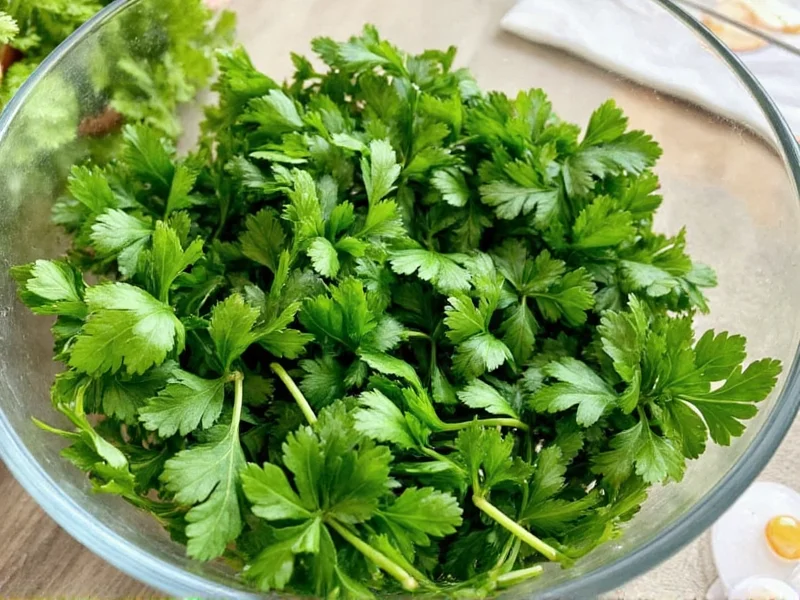2 tablespoons of fresh parsley equals approximately 2/3 tablespoon (0.67 tbsp) of dried parsley. This follows the standard 3:1 fresh-to-dried herb conversion ratio, where you use one-third the amount of dried herbs compared to fresh due to their concentrated flavor after dehydration.
When converting fresh herbs to dried in your cooking, understanding the precise measurements can make the difference between a perfectly seasoned dish and an overpowering one. The conversion from fresh to dried parsley follows a consistent culinary principle that applies to most leafy herbs. This guide provides accurate measurements, explains the science behind herb concentration, and offers practical tips for using dried parsley effectively in your recipes.
Why Fresh and Dried Herbs Require Different Measurements
Fresh parsley contains approximately 85-90% water, which evaporates during the drying process. This dehydration concentrates the essential oils and flavor compounds, making dried parsley significantly more potent by volume. When you're wondering how much dried parsley equals 2 tablespoons fresh, the answer lies in this concentration effect.
The standard conversion ratio across professional culinary circles is 3 parts fresh herb to 1 part dried herb. This means for every 3 tablespoons of fresh parsley, you'll need just 1 tablespoon of dried parsley to achieve similar flavor intensity. Understanding this fresh parsley to dried parsley ratio prevents common seasoning mistakes that can ruin your dishes.
Parsley Conversion Chart for Common Measurements
| Fresh Parsley | Dried Parsley | Teaspoon Equivalent |
|---|---|---|
| 1 teaspoon | ⅓ teaspoon | ⅓ tsp |
| 1 tablespoon | 1 teaspoon | 1 tsp |
| 2 tablespoons | 2/3 tablespoon | 2 tsp |
| ¼ cup | 1¼ tablespoons | 3¾ tsp |
| ½ cup | 2½ tablespoons | 7½ tsp |
As shown in the chart, 2 tablespoons fresh parsley to dried conversion equals precisely 2/3 tablespoon, which conveniently measures as 2 teaspoons. This teaspoon measurement often proves more practical when cooking, as most kitchens find it easier to measure teaspoons accurately than fractional tablespoons.
Factors That Affect the Conversion Ratio
While the 3:1 ratio serves as a reliable guideline for substituting dried parsley for fresh in recipes, several factors can influence the ideal conversion:
- Herb quality: Premium dried parsley retains more flavor than lower-quality varieties
- Storage duration: Dried herbs lose potency over time (typically 6-12 months)
- Recipe type: Long-cooking dishes may require slightly less dried herb
- Personal preference: Some cooks prefer a more subtle or pronounced herb flavor
For delicate dishes like fish or egg preparations, consider using ½ teaspoon of dried parsley instead of the full 2 teaspoons when converting from 2 tablespoons fresh. In robust recipes like stews or tomato sauces, you might even use the full 2 teaspoons or slightly more to achieve the desired flavor profile.
Maximizing Flavor When Using Dried Parsley
To get the most from your dried parsley equivalent to fresh conversion, follow these professional techniques:
- Bloom in oil: Heat dried parsley in a small amount of oil for 30-60 seconds before adding to dishes
- Add early: Incorporate dried herbs at the beginning of cooking to allow flavors to develop
- Rehydrate: For salads or cold dishes, soak dried parsley in warm water for 5 minutes first
- Grind between fingers: Rub dried parsley between your palms to release essential oils
Unlike fresh parsley, which works best as a finishing garnish, dried parsley benefits from longer cooking times that allow its concentrated flavors to distribute evenly throughout the dish. This explains why the 2 tablespoons fresh parsley to dried conversion requires careful consideration of your cooking method.
Common Mistakes to Avoid
Many home cooks make these critical errors when converting fresh to dried herbs:
- Using equal measurements (1:1 ratio) instead of the proper 3:1 conversion
- Adding dried herbs at the same stage as fresh herbs would be added
- Not accounting for the age of dried herbs (older = less potent)
- Measuring dried herbs without properly fluffing them first
When working with older dried parsley that's been stored for more than 6 months, you may need to increase the amount by 25-50% to achieve the same flavor intensity as fresh. Always check the aroma of your dried herbs before using them—if they have little scent, they've likely lost much of their flavor potency.
Storing Dried Parsley for Maximum Freshness
Proper storage significantly impacts how well your dried parsley equivalent to fresh conversion will work in recipes:
- Store in airtight containers away from light and heat
- Keep away from spices with strong odors that can transfer flavors
- Label containers with purchase date (optimal use within 6-12 months)
- Never store above the stove where heat and humidity fluctuate
For the most accurate fresh parsley to dried parsley ratio results, measure dried herbs by gently spooning them into your measuring spoon rather than scooping directly from the container. This prevents compaction, which would give you too much herb and potentially overpower your dish.











 浙公网安备
33010002000092号
浙公网安备
33010002000092号 浙B2-20120091-4
浙B2-20120091-4